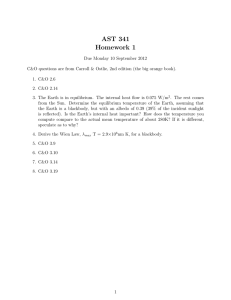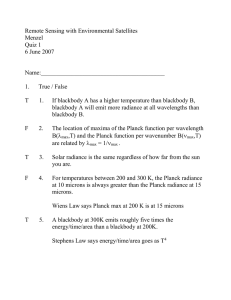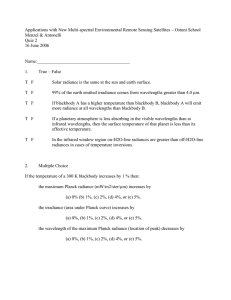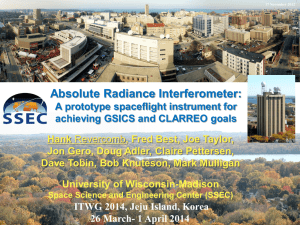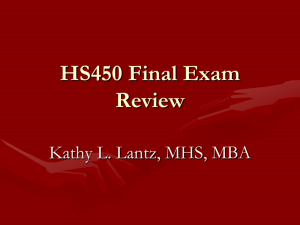On-Orbit Absolute Radiance Standard for the
advertisement
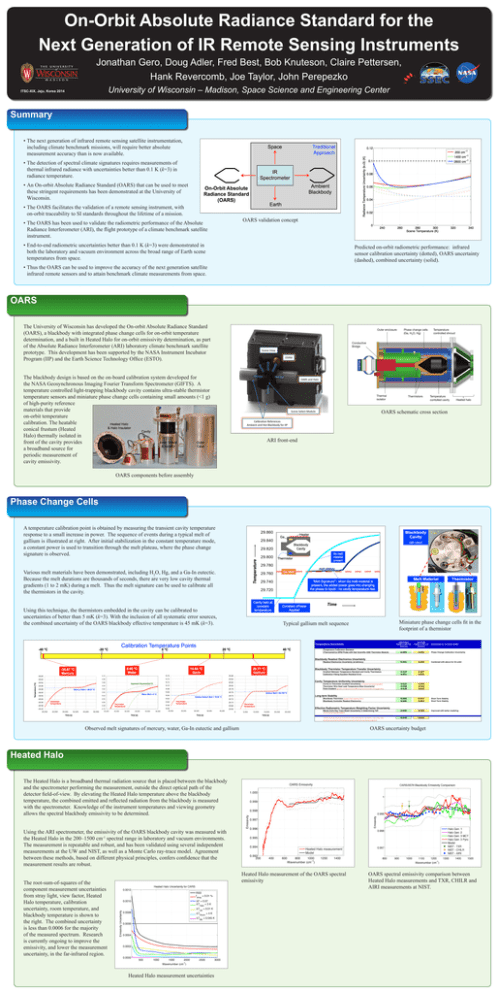
On-Orbit Absolute Radiance Standard for the Next Generation of IR Remote Sensing Instruments Jonathan Gero, Doug Adler, Fred Best, Bob Knuteson, Claire Pettersen, Hank Revercomb, Joe Taylor, John Perepezko University of Wisconsin – Madison, Space Science and Engineering Center ITSC-XIX, Jeju, Korea 2014 Summary •The next generation of infrared remote sensing satellite instrumentation, including climate benchmark missions, will require better absolute measurement accuracy than is now available. •The detection of spectral climate signatures requires measurements of thermal infrared radiance with uncertainties better than 0.1 K (k=3) in radiance temperature. •An On-orbit Absolute Radiance Standard (OARS) that can be used to meet these stringent requirements has been demonstrated at the University of Wisconsin. •The OARS facilitates the validation of a remote sensing instrument, with on‑orbit traceability to SI standards throughout the lifetime of a mission. •The OARS has been used to validate the radiometric performance of the Absolute Radiance Interferometer (ARI), the flight prototype of a climate benchmark satellite instrument. OARS validation concept •End-to-end radiometric uncertainties better than 0.1 K (k=3) were demonstrated in both the laboratory and vacuum environment across the broad range of Earth scene temperatures from space. Predicted on-orbit radiometric performance: infrared sensor calibration uncertainty (dotted), OARS uncertainty (dashed), combined uncertainty (solid). •Thus the OARS can be used to improve the accuracy of the next generation satellite infrared remote sensors and to attain benchmark climate measurements from space. OARS The University of Wisconsin has developed the On-orbit Absolute Radiance Standard (OARS), a blackbody with integrated phase change cells for on-orbit temperature determination, and a built in Heated Halo for on-orbit emissivity determination, as part of the Absolute Radiance Interferometer (ARI) laboratory climate benchmark satellite prototype. This development has been supported by the NASA Instrument Incubator . Program (IIP) and the Earth Science Technology Office (ESTO). =<.:.6,47;=:. 1*;.,1*60.,.44; *0 $.58.:*<=:. ,76<:744.-;1:7=- /,%,"3& 76-=,<2>. :2-0. The blackbody design is based on the on-board calibration system developed for the NASA Geosynchronous Imaging Fourier Transform Spectrometer (GIFTS). A temperature controlled light-trapping blackbody cavity contains ultra-stable thermistor temperature sensors and miniature phase change cells containing small amounts (<1 g) of high-purity reference materials that provide on-orbit temperature calibration. The heatable conical frustum (Heated Halo) thermally isolated in front of the cavity provides a broadband source for periodic measurement of cavity emissivity. $1.:5*4 2;74*<7: $1.:52;<7:; $.58.:*<=:. ,76<744.-,*>2<A .*<.-1*47 OARS schematic cross section ARI front-end OARS components before assembly Phase Change Cells = A temperature calibration point is obtained by measuring the transient cavity temperature response to a small increase in power. The sequence of events during a typical melt of gallium is illustrated at right. After initial stabilization in the constant temperature mode, a constant power is used to transition through the melt plateau, where the phase change signature is observed. Various melt materials have been demonstrated, including H2O, Hg, and a Ga-In eutectic. Because the melt durations are thousands of seconds, there are very low cavity thermal gradients (1 to 2 mK) during a melt. Thus the melt signature can be used to calibrate all the thermistors in the cavity. Using this technique, the thermistors embedded in the cavity can be calibrated to uncertainties of better than 5 mK (k=3). With the inclusion of all systematic error sources, the combined uncertainty of the OARS blackbody effective temperature is 45 mK (k=3). Typical gallium melt sequence Observed melt signatures of mercury, water, Ga-In eutectic and gallium Miniature phase change cells fit in the footprint of a thermistor OARS uncertainty budget Heated Halo Using the ARI spectrometer, the emissivity of the OARS blackbody cavity was measured with the Heated Halo in the 200–1500 cm-1 spectral range in laboratory and vacuum environments. The measurement is repeatable and robust, and has been validated using several independent measurements at the UW and NIST, as well as a Monte Carlo ray-trace model. Agreement between these methods, based on different physical principles, confers confidence that the measurement results are robust. OARS Emissivity 1.000 0.999 0.998 Emissivity The Heated Halo is a broadband thermal radiation source that is placed between the blackbody and the spectrometer performing the measurement, outside the direct optical path of the detector field-of-view. By elevating the Heated Halo temperature above the blackbody temperature, the combined emitted and reflected radiation from the blackbody is measured with the spectrometer. Knowledge of the instrument temperatures and viewing geometry allows the spectral blackbody emissivity to be determined. 0.997 0.996 0.995 0.994 0.993 200 Heated Halo measurement Model 400 600 800 1000 Wavenumber (cm−1) 1200 1400 Heated Halo measurement of the OARS spectral emissivity The root-sum-of-squares of the component measurement uncertainties from stray light, view factor, Heated Halo temperature, calibration uncertainty, room temperature, and blackbody temperature is shown to the right. The combined uncertainty is less than 0.0006 for the majority of the measured spectrum. Research is currently ongoing to improve the emissivity, and lower the measurement uncertainty, in the far-infrared region. Heated Halo measurement uncertainties OARS spectral emissivity comparison between Heated Halo measurements and TXR, CHILR and AIRI measurements at NIST.

